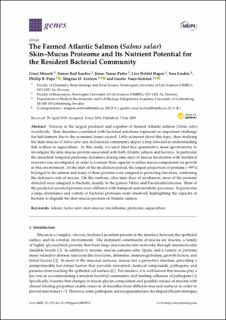| dc.contributor.author | Minniti, Giusi | |
| dc.contributor.author | Sandve, Simen Rød | |
| dc.contributor.author | Padra, JT | |
| dc.contributor.author | Hagen., Live Heldal | |
| dc.contributor.author | Lindén, S | |
| dc.contributor.author | Pope, Phillip | |
| dc.contributor.author | Arntzen, Magnus Øverlie | |
| dc.contributor.author | Vaaje-Kolstad, Gustav | |
| dc.date.accessioned | 2020-11-09T14:45:08Z | |
| dc.date.available | 2020-11-09T14:45:08Z | |
| dc.date.created | 2019-09-24T13:08:06Z | |
| dc.date.issued | 2019 | |
| dc.identifier.issn | 2073-4425 | |
| dc.identifier.uri | https://hdl.handle.net/11250/2686976 | |
| dc.description.abstract | Norway is the largest producer and exporter of farmed Atlantic salmon (Salmo salar) worldwide. Skin disorders correlated with bacterial infections represent an important challenge for fish farmers due to the economic losses caused. Little is known about this topic, thus studying the skin–mucus of Salmosalar and its bacterial community depict a step forward in understanding fish welfare in aquaculture. In this study, we used label free quantitative mass spectrometry to investigate the skin–mucus proteins associated with both Atlantic salmon and bacteria. In particular, the microbial temporal proteome dynamics during nine days of mucus incubation with sterilized seawaterwasinvestigated,inordertoevaluatetheircapacitytoutilizemucuscomponentsforgrowth in this environment. At the start of the incubation period, the largest proportion of proteins (~99%) , belonged to
the salmon and many of these proteins were assigned to protecting functions
confirming the defensive role of mucus. On the contrary, after nine days of incubation, most of the proteins detected were assigned to bacteria, mainly to the genera Vibrio and Pseudoalteromonas. Most of the predicted secreted proteins were affiliated with transport and metabolic processes. In particular, a large abundance and variety of bacterial proteases were observed, highlighting the capacity of bacteria to degrade the skin–mucus proteins of Atlantic salmon. | en_US |
| dc.language.iso | eng | en_US |
| dc.rights | Navngivelse 4.0 Internasjonal | * |
| dc.rights | Navngivelse 4.0 Internasjonal | * |
| dc.rights.uri | http://creativecommons.org/licenses/by/4.0/deed.no | * |
| dc.title | The Farmed Atlantic Salmon (Salmo salar) Skin-Mucus Proteome and Its Nutrient Potential for the Resident Bacterial Community | en_US |
| dc.type | Peer reviewed | en_US |
| dc.type | Journal article | en_US |
| dc.description.version | publishedVersion | en_US |
| dc.source.volume | 10 | en_US |
| dc.source.journal | Genes | en_US |
| dc.source.issue | 7 | en_US |
| dc.identifier.doi | 10.3390/genes10070515 | |
| dc.identifier.cristin | 1728312 | |
| dc.relation.project | EC/FP7/ERC-336355 | en_US |
| dc.relation.project | Norges forskningsråd: 249865 | en_US |
| cristin.unitcode | 192,12,0,0 | |
| cristin.unitcode | 192,10,1,0 | |
| cristin.unitname | Kjemi, bioteknologi og matvitenskap | |
| cristin.unitname | Institutt for husdyr- og akvakulturvitenskap | |
| cristin.ispublished | true | |
| cristin.fulltext | original | |
| cristin.qualitycode | 1 | |

